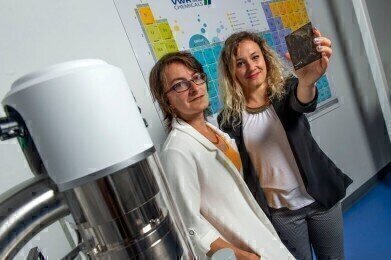-
 (l-r) Dr Maria McNamara and Valentina Rossi led the study in collaboration with a team of chemists from the US and Japan
(l-r) Dr Maria McNamara and Valentina Rossi led the study in collaboration with a team of chemists from the US and Japan
News
Building from the Inside Out – Fossils Reveal Hidden Secrets
Oct 08 2019
By studying the remains of fossilized internal organs, Palaeontologists at University College Cork (UCC) have discovered a way to unlock more accurate information on the anatomy of ancient vertebrate animals. In this breakthrough study*, led by UCC’s Valentina Rossi and her supervisor Dr Maria McNamara in collaboration with an international team of chemists from the US and Japan, cutting-edge synchrotron techniques were used to analyse the chemistry of the fossil and modern melanosomes using X-rays, allowing them to peer inside the anatomy of fossils and uncover hidden features.
While previous studies have mainly been focused on the skin and feathers, the approach adopted by the UCC team was able to link the pigment is to visible colour. Unexpectedly, the new study also showed that melanin is abundant in internal organs of modern amphibians, reptiles, birds and mammals, and their fossil counterparts.
“This discovery is remarkable in that it opens up a new avenue for reconstructing the anatomy of ancient animals. In some of our fossils we can identify skin, lungs, the liver, the gut, the heart, and even connective tissue,” said senior author Dr Maria McNamara. “What’s more, this suggests that melanin had very ancient functions in regulating metal chemistry in the body going back tens, if not hundreds, of millions of years.”
The team made the initial discovery of internal melanosomes last year on fossil frogs. “After the pilot study, we had a hunch that these features would turn out to be more widespread across vertebrates. But we never guessed that the chemistry would be different in different organs,” Rossi said.
The advent of new synchrotron X-ray analysis techniques “allows us to harness the energy of really fast-moving electrons to detect minute quantities of different metals in the melanosomes.”
The fossils are so well-preserved that even the melanin molecule can be detected, the scientists added.
Published in Proceedings of the National Academy of Sciences of the United States of America
Digital Edition
Lab Asia Dec 2025
December 2025
Chromatography Articles- Cutting-edge sample preparation tools help laboratories to stay ahead of the curveMass Spectrometry & Spectroscopy Articles- Unlocking the complexity of metabolomics: Pushi...
View all digital editions
Events
Jan 21 2026 Tokyo, Japan
Jan 28 2026 Tokyo, Japan
Jan 29 2026 New Delhi, India
Feb 07 2026 Boston, MA, USA
Asia Pharma Expo/Asia Lab Expo
Feb 12 2026 Dhaka, Bangladesh


















